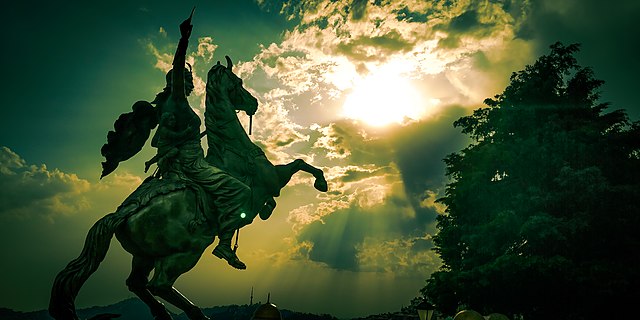Jhansi Ki Rani Lakshmibai, the courageous soul , stands as a beacon of bravery and determination in Indian history. Born in a revered Karhada Brahmin family in Benares in 1828, she became the Maharani of Jhansi upon her marriage to Maharaja Gangadhar Rao Newalkar in 1842. However, tragedy struck when her husband passed away in 1853, and the British East India Company, under Lord Dalhousie, seized the opportunity to annex Jhansi, disregarding her adopted heir.
Refusing to bow down, Lakshmibai joined the Indian Rebellion of 1857, becoming a symbol of fierce resistance against British rule. She valiantly defended Jhansi against British forces and, despite the odds, managed to escape their clutches. Alongside fellow rebels, she played a vital role in capturing Gwalior, proclaiming Nana Saheb as the Peshwa of the revived Maratha Empire.
Her legacy reverberates through the ages, inspiring generations with her audacity and patriotism. Lakshmibai’s unwavering spirit during the struggle for independence has immortalized her as a national hero, reminding the world of the indomitable courage of Indian women in the face of adversity. Her tale resonates far beyond history books, embodying the essence of resilience and the fight for freedom.
Jhansi Ki Rani Lakshmibai: Defying Norms, Embracing Courage
Rani Lakshmibai, born in Benares in 1828, defied the societal norms of her time, carving her path marked by courage and resilience. Raised in a Karhada Brahmin family, she was named Manikarnika Tambe and affectionately called Manu. Despite the loss of her mother at an early age, she received an unconventional upbringing. Her father, Moropant Tambe, a Commander in the war of Kalyanpranth, educated her at home. Unlike other girls, she was taught reading, writing, horsemanship, fencing, and mallakhamba, showcasing her early independence.
Rani Lakshmibai’s spirit shone brightly against the backdrop of patriarchal expectations. The Peshwa, Baji Rao II of Bithoor, fondly called her “Chhabili,” signifying her beauty and liveliness. Fearless and determined, she rode horses like Sarangi, Pavan, and Baadal. Baadal, in particular, became significant; it was the horse she rode during her daring escape from the fort in 1858.
Her residence, the Rani Mahal, a testament to her legacy, now stands as a museum, preserving the rich archaeological heritage from the 9th to 12th centuries AD. Rani Lakshmibai’s story echoes through history, a beacon of bravery and defiance against societal constraints, inspiring generations to challenge norms and embrace their strength.

Jhansi ki Rani Lakshmibai: A Saga of Courage and Defiance
Born as Manikarnika, she transformed into Rani Lakshmibai upon her marriage to Maharaja Gangadhar Rao Newalkar of Jhansi in 1842. Her life, marked by tragedies, took a turn in September 1851 when she gave birth to a son, Damodar Rao. However, destiny had other plans; he succumbed to illness at just four months. The Maharaja, undeterred, adopted Anand Rao, his cousin’s son, renaming him Damodar Rao. But the British East India Company, applying the Doctrine of Lapse, denied Damodar Rao’s claim after the Maharaja’s death in 1853.
Undeterred, Rani Lakshmibai fiercely contested, exclaiming, “Main apni Jhansi nahi doongi” (I shall not surrender my Jhansi). Despite facing exile from her own palace and fort, she stood tall. Her indomitable spirit shone in her daily routine, where she engaged in rigorous exercises like weightlifting, wrestling, and steeplechasing before breakfast. Known for her simplicity and intelligence, she ruled Jhansi in a remarkably businesslike manner. Rani Lakshmibai’s life story resonates through history as a symbol of unwavering courage and resilience.
The Brave Heart of India: Heroic Saga Jhansi Ki Rani Lakshmibai
In the annals of India’s freedom struggle, Rani Lakshmibai of Jhansi stands as a formidable symbol of resilience and bravery. Born in 1828 in Benares, she entered history’s pages as the Joan of Arc of India. The seeds of rebellion were sowed in 1857 when the Indian Rebellion erupted in Meerut. Amid the chaos, Rani Lakshmibai, understanding the impending threat, sought protection for her kingdom. She conducted ceremonies, reassuring her subjects of the British’s cowardice, rallying them against the looming oppression.
However, Lakshmibai‘s transformation into a rebel leader was catalyzed by the massacre at the Star Fort of Jhansi. In a gruesome episode, British officers and their families were brutally slain, leading to a fierce retaliation. The Rani, now the city’s de facto authority, wrote to the British, managing Jhansi for them. Yet, the British aid she hoped for never arrived.
Under siege, she resorted to self-defense, fortifying Jhansi with cannons and brave soldiers, ensuring the city’s resilience. When the British forces finally attacked in March 1858, she stood her ground, defending her kingdom with unmatched valor. The city was bombarded, but Rani Lakshmibai’s spirit remained unbroken. Her courage echoed through her proclamation: “We fight for independence. In the words of Lord Krishna, we will enjoy the fruits of victory or earn eternal glory and salvation.”
The siege was fierce, defending against British forces under Sir Hugh Rose, she repaired the city’s defences, seeking help from Tatya Tope. Despite Tatya Tope’s efforts he gets stuck into another faceoff, Jhansi faced a fierce assault, Jhansi’s defenders engaging in street battles against the British onslaught. Rani Lakshmibai, her son Damodar Rao on her back, mounted her horse Badal, attempting to escape the fort. In the dead of night, she fled, surrounded by her devoted guards, leaping to survival as her horse succumbed.
Her journey continued, rallying forces, defending towns, until she reached Gwalior. Here, amidst escalating battles, she led the Indian forces. Despite her relentless efforts, Gwalior eventually fell to the British, marking a tragic turn in her heroic saga.
Rani Lakshmibai’s legacy lives on, a testament to her unwavering spirit. She remains an immortal symbol of India’s fight for freedom, her bravery etched in every chapter of the nation’s history. Her sacrifice and valor continue to inspire generations, reminding the world of the fierce determination of India’s warrior queen.
The Brave End of Jhansi Ki Rani Lakshmibai
In the final throes of the Indian Rebellion, Rani Lakshmibai’s valor blazed brightly even in the face of impending defeat. On 17 June, near the Phool Bagh of Gwalior, she led a formidable force against the British, desperately trying to escape the encroaching enemy. The 8th Hussars, under Captain Heneage, charged into her ranks, resulting in a fierce battle. Amidst the chaos, Lakshmibai, donned in a sowar’s uniform, personally fought on the front lines. In the heart of the struggle, she was unhorsed and wounded, displaying unmatched bravery.
In a tragic turn, injured and bleeding, she recognized her assailant, a hussar, and fired at him. In retaliation, he swiftly ended her life, preventing her capture by the British as she asked a hermit to cremate her and few local people helped in that . Despite her courageous resistance, Gwalior fell into the hands of the British after three days. The saga of Jhansi Ki Rani Lakshmibai, her courage undimmed even in defeat, remains etched in history, a testament to her unwavering spirit and unyielding fight for her people.



